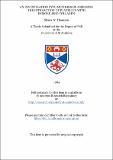Files in this item
An investigation into methods of assessing the interaction of platelets with immobilised collagen
Item metadata
| dc.contributor.advisor | Kemp, Graham | |
| dc.contributor.author | Thomson, Shana W. | |
| dc.coverage.spatial | 111 p. | en_US |
| dc.date.accessioned | 2018-07-04T11:34:28Z | |
| dc.date.available | 2018-07-04T11:34:28Z | |
| dc.date.issued | 1984 | |
| dc.identifier.uri | https://hdl.handle.net/10023/14910 | |
| dc.description.abstract | When platelets come into contact with collagen, they adhere to it then release the contents of their dense granules and granules and aggregate together. This interaction is dependent on the conformation and degree of multimerisation of the collagen as well as the experimental conditions. The fibrillar state of collagen varies with the pH and ionic strength of the solution so collagen was immobilised on to an insoluble support in order that its fibrillar state should remain unchanged during exposure to platelets and during modification. The first support used was polyamide sheet, but although the resulting collagen-strips induced measurable platelet adhesion and aggregation, there was insufficient collagen present to induce adequate aggregation or serotonin release to be of use in investigating these interactions. Sepharose 6B was then used as a support for collagen and this proved satisfactory, inducing approximately 20% serotonin release from platelets. The release reaction is nearer to the initial interaction between platelets and collagen than aggregation, which is the final step, and it therefore allows a better insight into the conditions necessary for the interaction to take place. The amino groups of collagen-Sepharose were modified in three ways, using succinic anhydride, trinitrobenzene sulphonic acid and dinitrofluorobenzene. Succinylation almost abolished serotonin release while di-and trinitrophenylation enhanced this reaction. amino groups of collagen are therefore not in themselves important in the recognition of collagen by platelets and the subsequent reactions, since they were blocked by the modifications. The suggestion is made that succinylation disrupted the fibrils because of the change in charge whereas di- and trinitrophenylation merely neutralised the charge and permitted realignment of any previously misaligned areas of the molecule. These results reinforce theories that the correct quaternary structure of collagen must be present in order that it will be recognised by platelets. | en_US |
| dc.language.iso | en | en_US |
| dc.publisher | University of St Andrews | |
| dc.subject.lcc | QP97.T7 | |
| dc.subject.lcsh | Blood platelets | en |
| dc.title | An investigation into methods of assessing the interaction of platelets with immobilised collagen | en_US |
| dc.type | Thesis | en_US |
| dc.contributor.sponsor | James MacKenzie student fellowship | en_US |
| dc.type.qualificationlevel | Doctoral | en_US |
| dc.type.qualificationname | PhD Doctor of Philosophy | en_US |
| dc.publisher.institution | The University of St Andrews | en_US |
This item appears in the following Collection(s)
Items in the St Andrews Research Repository are protected by copyright, with all rights reserved, unless otherwise indicated.

